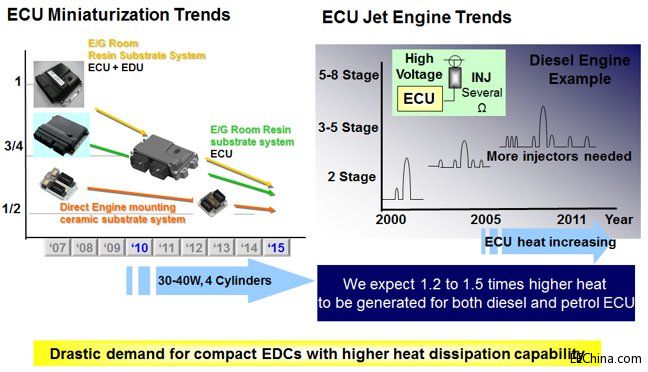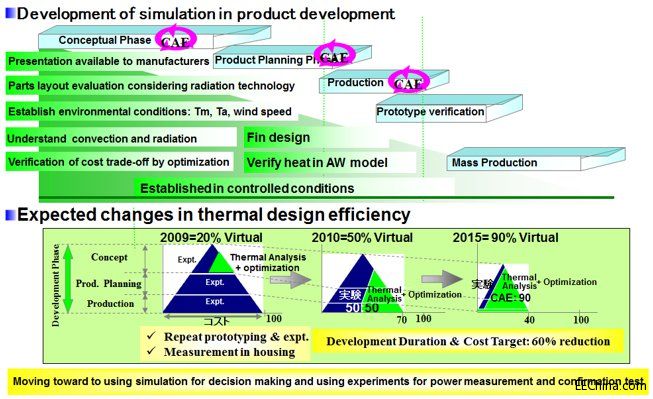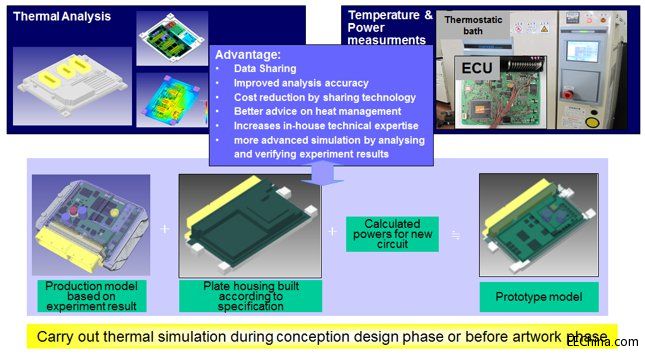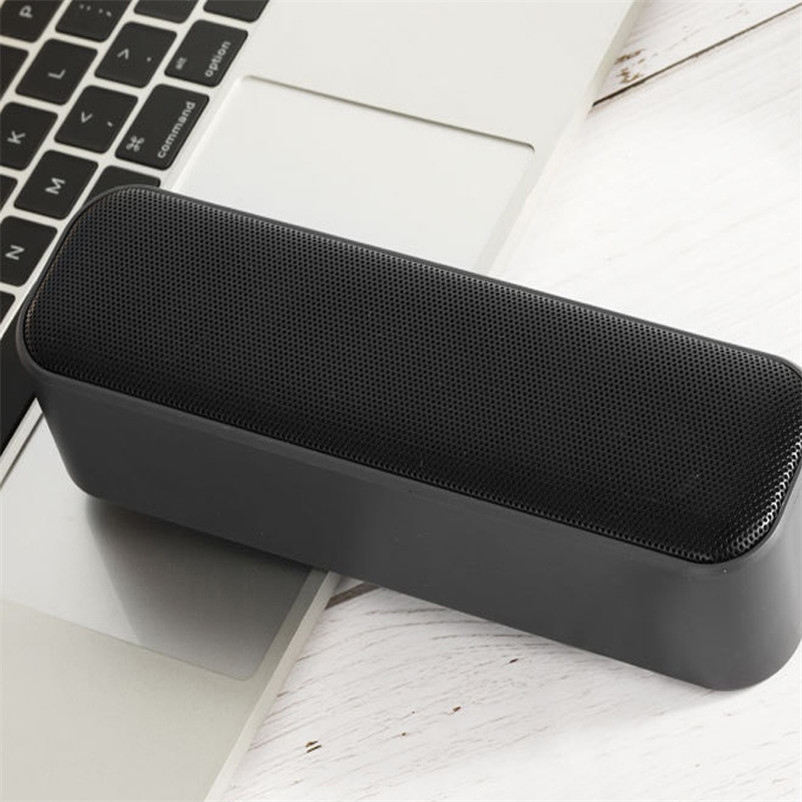introduction
This article refers to the address: http://
DENSO Corporation is a leading automotive supplier dedicated to the design and manufacture of advanced vehicle control technologies, systems and components for large automotive manufacturers worldwide. Founded in 1949, Denso is headquartered in Kariya, Japan, and operates in 35 countries and regions. The number of employees worldwide is approximately 120,000. The company's electronic systems business unit provides engines, conveyors, power management electronic control units (ECUs), and semiconductor sensors, integrated circuits, and power modules.
I met with Takuya Shinoda, Project Manager Assistant, Product Technology Planning, Electronics Engineering Division 2, to discuss how Denso uses thermal simulation to significantly reduce design time and cost. Takuya Shinoda is responsible for the thermal design of the engine control unit. Shinoda is proficient in mechanics and electricals. As he puts it, “Thermal design closely links the two disciplines of mechanics and electrical. Thermal management mainly involves mechanical problems, and heat is generated in silicon, so it is also necessary to master electronics in order to properly design thermal.â€
Design challenge
The ECUs for vehicles and parts are particularly complex when manufacturing energy-efficient, environmentally-friendly vehicles. Successful thermal design is critical to the manufacturer.

Figure 1: Reduced component size to promote thermal technology development
The junction temperature of an integrated circuit or field effect transistor (FET) that contributes to such a vehicle system must be within the normal operating temperature range. Since it is not possible to directly measure the junction temperature, engineers used to predict the junction temperature of electronic components based on assumptions about the surface temperature measurement and set a broader design redundancy.
In order to cope with the current fierce price competition, quality assurance, optimization of design redundancy and overall cost-effectiveness are very important.
Simulation saves product design time and cost
Shinoda first saw the fluid flow visualization of the board at an exhibition and began looking for a thermal design tool in 2006. Denso rejected other tools through rigorous benchmarking and chose FloTHERM® and FloTHERM® PCBs for the thermal design process.
Before the electrical installation began to use thermal simulation, the temperature was measured early by the physical ECU prototype. It usually takes 2-3 weeks to prepare for a half-day test, which may have to be repeated several times before the product is formed.
Since 2006, Denso has been strengthening the use of simulation software to reduce the time and cost of physical prototypes. In 2009, the ratio of simulation to physical prototype use was 20:80, and by 2010 it had increased to 50:50. In 2012 it reached 70:30. This shift reduced the time and cost associated with thermal design by 50% in less than six years. The Denso plan further increases the use of simulations and will increase this ratio to over 90:10 by 2015.

Figure 2: Technological innovations in thermal management
Benefit from the centralization of thermal expertise
Denso is centralized by thermal technology, successfully introducing thermal analysis into the production process, and applying this expertise to the entire company. By understanding the needs of different design departments, Shinoda's thermal department has been able to use thermal simulations to improve heat dissipation efficiency through continuous experimental experience, thus rapidly improving design quality.
In terms of thermal design, designers often enhance the heat dissipation by changing the shape of the case. The best results can be achieved by sharing the shape of the shell and the electronic design among the members of the thermal design team. Denso has decided to use the existing component model (Figure 3). The mechanical group created a smaller product casing, and the circuit design group redesigned the circuit by 10%-20% according to the new specification, while the measurement group took the temperature for thermal analysis. Through cooperation, Denso can produce a working thermal model of the product within two days. This is inseparable from the efforts of the engineers in each group.

Figure 3: The advantages of thermal technology centralization - simulation and measurement
Improve the accuracy of simulation
In addition to the above mentioned hopes that physical prototypes are no longer used, measurements play a very important role in the thermal design of electrical equipment. To support thermal simulation, Denso uses T3SterTM to demonstrate the different characteristics of the ECU components and thermal interface resistance during the simulation. The accuracy of the T3Ster data allows Denso to improve the accuracy of its thermal simulations, allowing them to use simulation results with confidence.
Entering T3ster measurement data into FloTHERM improves the junction temperature prediction accuracy in the design, ensuring that the junction temperature does not exceed the specified limits. This requirement is very high and requires a strong confidence in the simulation model. The consensus temperature rise range must now be within 10% of the test value. Denso hopes to further control this range to 5% by 2015.
Shinoda explained: “The JEDEC JESD51-14 standard was released in 2010. Its accuracy and repeatability far exceeds the steady-state measurement that follows the old standard. T3Ster is the only product on the market that meets this new standard and can accurately estimate heat. Resistance and junction temperature. In addition, using T3Ster's unique structural functions, simple and accurate component models can also be generated from measurement data."
Denso found it necessary to make accurate measurements with electronic components to improve the accuracy of the simulation, thereby eliminating excessive thermal margins in the design.
The FloTHERM product line (including FloTHERM PCB and FloTHERM PACK) has become an important toolkit for the entire thermal design process of Denso. With the support of high-precision package thermal models, material property data and interface resistance values ​​obtained through T3Ster measurements, Mentor's thermal solutions have helped Denso achieve over 90% virtualization in thermal design while enabling development time and The cost has been reduced by more than 50% and is expected to be further improved in the future.
Shinoda said: "Our printed circuit board designers use FloTHERM PCB, which has a user-friendly user interface and is connected to FloTHERM PACK. In addition, we have also obtained IDAJ and KOZO KEIKAKU ENGINEERING distributors of thermal conductivity analysis tools. Strong support from the Institute of Painting."
This Computer Speaker is powered by USB interface on computers or laptops, plug and play, save energy. 3W output brings you high-quality clear binaural sound. Lightweight and portable design makes you can hold it with single hand, save space on the desk. Made of ABS and TPU, which makes this speaker durable and firm. Believe it is a great companion for your computer and laptop.

Computer Speaker
Usb Powered Speaker,Usb Small Speakers,Mini Portable Speakers,Desktop Mini Speakers
SHENZHEN HONK ELECTRONIC CO., LTD , https://www.honktech.com